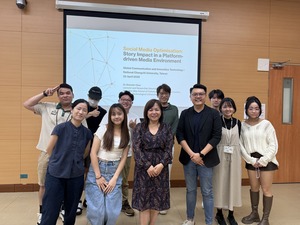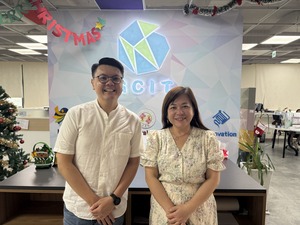GCIT Digital Journalism Series: Singapore Scholar Explores Data Narratives, Social Media Optimization, and Platform Power




【Article by GCIT】
The Master's Program in Global Communication and Innovation Technology (GCIT) at National Chengchi University hosted a three-day “Frontiers in Digital Journalism” lecture series from April 21 to 23, 2025. Invited by GCIT Distinguished Professor and Director Dr. Trisha Lin, Dr. Sherwin Chua, journalism lecturer at Nanyang Technological University in Singapore, delivered a series of workshops and a keynote lecture. Covering topics from data journalism and social media strategies to platform power dynamics in newsrooms, the events offered students and faculty comprehensive insights into the evolving digital journalism landscape.
Telling Stories with Data: Building Public Dialogue Through Data Journalism
One of GCIT’s educational focuses is international journalism training. With his background as a reporter and editor in Singapore, Dr. Chua brings extensive hands-on experience in digital journalism, newsroom research, and international collaboration. Director Lin emphasized that Dr. Chua’s expertise in storytelling through data and multimedia, combined with his understanding of social media engagement, aligns with GCIT’s mission.
In the first workshop, “From Dataset to Story: Making Sense of the World through Numbers,” Dr. Chua demonstrated how to transform complex datasets into compelling narratives. “In the post-truth era,” he noted, “data journalism enhances transparency, strengthens fact-checking, and promotes public accountability.” He also highlighted Asia’s distinct data journalism landscape, where media often prioritize social harmony and information dissemination—contrasting with Western traditions of adversarial reporting. This contrast illustrates the cultural diversity of journalistic practices across regions.
Dr. Chua introduced the “5Cs of Data Journalism”: Compile, Clean, Contextualize, Combine, and Communicate. Participants explored tools such as Google Journalist Studio and engaged in hands-on group projects. Student topics included healthcare workforce comparisons, social dynamics in recall campaigns, and age demographics in tourism—showcasing how data lies at the heart of impactful storytelling.
Optimizing for Impact: Social Media Strategies in a Platform-Driven World
In the second workshop, “Social Media Optimisation: Strategies for Story Impact in a Platform-Driven World,” Dr. Chua explored how algorithmic logic, virality, and platform metrics influence modern journalism. He shared three key strategies: leveraging trending keywords with Google Trends, crafting platform-friendly video formats (e.g., vertical videos with subtitles), and using effective hashtags to increase reach.
Students conducted A/B tests using real news content, including an accident at a university construction site, to evaluate how different storytelling techniques affected audience engagement. Dr. Chua emphasized the delicate balance between maintaining journalism’s public value and maximizing algorithmic exposure: “Media today must navigate both civic responsibilities and platform-driven imperatives.”
Platform Power and Newsroom Innovation: The Dialectic Between Agency and Dependency
In the concluding keynote, “Navigating Platform Power: Journalism Innovation and the Digital Materiality of Social Media,” Dr. Chua presented findings from his long-term study of The Straits Times (2015–2021). He analyzed how the newsroom adapted to the shifting platform ecosystem, including Facebook algorithm changes and the mixed results of Instant Articles. These cases illustrate the deep dependency—and inherent risks—news outlets face in the platform economy.
Despite asymmetrical power dynamics, Chua argued that news organizations still retain agency in the digital age. He noted that AI tools can assist with data processing and ideation, but that journalistic writing and value judgments must remain rooted in human insight. Director Lin affirmed the importance of Dr. Chua’s longitudinal research on Singapore’s leading daily newspaper, encouraging GCIT students to draw from his methods in their own capstone research projects.
Multiple Perspectives, Deeper Learning
The digital journalism series was met with enthusiastic responses from GCIT faculty and students. One graduate student reflected: “Dr. Chua’s three sessions formed a complete knowledge system—from the foundations of data journalism and practical strategies for social media, to the theoretical exploration of platform power. It broadened our understanding of digital journalism from both professional and academic perspectives.”
This series not only equipped students with practical skills but also provided a theoretical foundation for critical reflection on the future of journalism. It exemplifies GCIT’s forward-thinking approach in communication and media innovation.
[此中英文稿和圖片以及全球傳播與創新科技碩士學位學程均獲得中華民國文化部的補助。]


 Fax:886-2-29379611
Fax:886-2-29379611